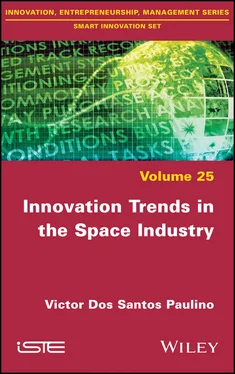1 Cover
2 Preface
3 Introduction
4 1 Theoretical and Empirical Framework 1.1. Innovation management: introductory elements 1.2. The space industry
5 2 The Emergence of Industry: The Influence of Demand 2.1. The space industry is in the emerging phase 2.2. Customers shape the industry dynamics in the emergence phase 2.3. Demand influences technological change
6 3 Slow Adoption of Innovations: A Key Success Factor 3.1. Slow adoption of technological innovations: a key success factor 3.2. Slow adoption of organizational innovations: a key success factor
7 4 Technological Discontinuities and Strategic Diagnosis 4.1. Disruptive innovations and threat analysis
8 Conclusion
9 References
10 Index
11 End User License Agreement
1 Chapter 2Table 2.1. Customers and adopters
2 Chapter 3Table 3.1. Cost of the failureTable 3.2. Extrinsic uncertainty values and technology distributionTable 3.3. Distribution of technologies according to the intensity of the inerti...Table 3.4. Regression results
3 Chapter 4Table 4.1. Characteristics of potential disruptive innovationsTable 4.2. New entrantsTable 4.3. Main satellite performance criteria [Source: adapted from Dos Santos ...Table 4.4. Small satellites are potential disruptive innovations [Source: adapte...
1 Chapter 1 Figure 1.1. The industry cycle: three dimensions (a, b, and c). For a color vers... Figure 1.2. Space economy: two value chains. For a color version of the figures ... Figure 1.3. Soyuz rocket at takeoff (Source: Pixabay). For a color version of th... Figure 1.4. Satellite (Source: Pixabay). For a color version of the figures in t... Figure 1.5. Spacecraft launched by application between 1957 and 2011Figure 1.6. Antennas in a ground station (Source: Pixabay). For a color version ...Figure 1.7. Space probe (Source: Pixabay). For a color version of the figures in...Figure 1.8. Purchases by customer type between 1957 and 2011Figure 1.9. Main institutional markets [Source: adapted from Révillon (2019)]
2 Chapter 2Figure 2.1. Adoption of product innovations (Source: Unknown, Forbes Magazine, J...Figure 2.2. Product lifecycle. For a color version of the figures in this chapte...Figure 2.3. Innovation adoption cycle. For a color version of the figures in thi...Figure 2.4. Innovation lifecycle. For a color version of the figures in this cha...Figure 2.5. Evolution of spacecraft launches. For a color version of the figures...Figure 2.6. Rate of product innovation in the space industry. For a color versio...Figure 2.7. Entry dynamics of adopters into the space industry. For a color vers...Figure 2.8. Evolution of the number of spacecraft launches according to their us...Figure 2.9. Patents filed in space technologies [Source: Dos Santos Paulino (201...Figure 2.10. Rate of innovation in launched spacecraft [Source: Dos Santos Pauli...
3 Chapter 3Figure 3.1. Organizational change and evolutionary perspectives [Source: adapted...Figure 3.2. Organizational inertia and survival in a risky environment
4 Chapter 4Figure 4.1. Disruptive and continuous technology [Source: adapted from Christens...Figure 4.2. Types of potential disruptive innovations. For a color version of th...Figure 4.3. Satellites launched by weight [Source: adapted from Dos Santos Pauli...Figure 4.4. Purchases made by customers who entered after 1990 and purchases mad...Figure 4.5. Purchases of small satellites by new customers [Source: adapted from...
1 Cover
2 Table of Contents
3 Begin Reading
1 v
2 ix
3 x
4 xi
5 xiii
6 xiv
7 xv
8 xvi
9 xvii
10 xviii
11 xix
12 xx
13 xxi
14 1
15 2
16 3
17 4
18 5
19 6
20 7
21 8
22 9
23 10
24 11
25 12
26 13
27 14
28 15
29 16
30 17
31 18
32 19
33 20
34 21
35 22
36 23
37 24
38 25
39 26
40 27
41 28
42 29
43 30
44 31
45 32
46 33
47 34
48 35
49 36
50 37
51 38
52 39
53 40
54 41
55 42
56 43
57 44
58 45
59 46
60 47
61 48
62 49
63 50
64 51
65 52
66 53
67 54
68 55
69 56
70 57
71 58
72 59
73 60
74 61
75 62
76 63
77 64
78 65
79 66
80 67
81 68
82 69
83 70
84 71
85 72
86 73
87 74
88 75
89 76
90 77
91 78
92 79
93 80
94 81
95 82
96 83
97 84
98 85
99 87
100 88
101 89
102 90
103 91
104 92
105 93
106 94
107 95
108 96
109 97
110 98
111 99
112 100
113 101
114 102
115 103
116 104
117 105
118 106
119 107
120 108
121 109
122 110
123 111
124 112
125 113
126 114
127 115
128 116
129 117
130 118
131 119
132 120
133 121
134 122
135 123
136 124
137 125
138 126
139 127
140 128
141 129
142 131
143 132
144 133
145 134
146 135
147 136
148 137
149 138
150 139
151 140
152 141
153 142
154 143
155 144
156 145
157 146
158 147
159 148
160 149
161 150
162 151
163 152
164 153
165 154
166 155
167 156
168 157
169 158
170 159
171 160
172 161
173 162
174 163
175 164
176 165
177 166
178 167
179 169
180 170
181 171
182 172
183 173
184 174
185 175
186 176
187 177
188 178
189 179
190 180
191 181
192 182
193 183
194 184
195 185
196 186
197 187
198 188
199 189
200 191
201 192
202 193
203 194
204 195
205 197
206 198
207 199
208 200
209 201
210 202
211 203
212 204
213 205
214 206
215 207
216 209
Smart Innovation Set
coordinated by
Dimitri Uzunidis
Volume 25
Innovation Trends in the Space Industry
Victor Dos Santos Paulino

First published 2020 in Great Britain and the United States by ISTE Ltd and John Wiley & Sons, Inc.
Apart from any fair dealing for the purposes of research or private study, or criticism or review, as permitted under the Copyright, Designs and Patents Act 1988, this publication may only be reproduced, stored or transmitted, in any form or by any means, with the prior permission in writing of the publishers, or in the case of reprographic reproduction in accordance with the terms and licenses issued by the CLA. Enquiries concerning reproduction outside these terms should be sent to the publishers at the undermentioned address:
ISTE Ltd
27-37 St George’s Road
London SW19 4EU
UK USA
www.iste.co.uk
John Wiley & Sons, Inc.
111 River Street
Hoboken, NJ 07030
www.wiley.com
© ISTE Ltd 2020
The rights of Victor Dos Santos Paulino to be identified as the author of this work have been asserted by him in accordance with the Copyright, Designs and Patents Act 1988.
Читать дальше













